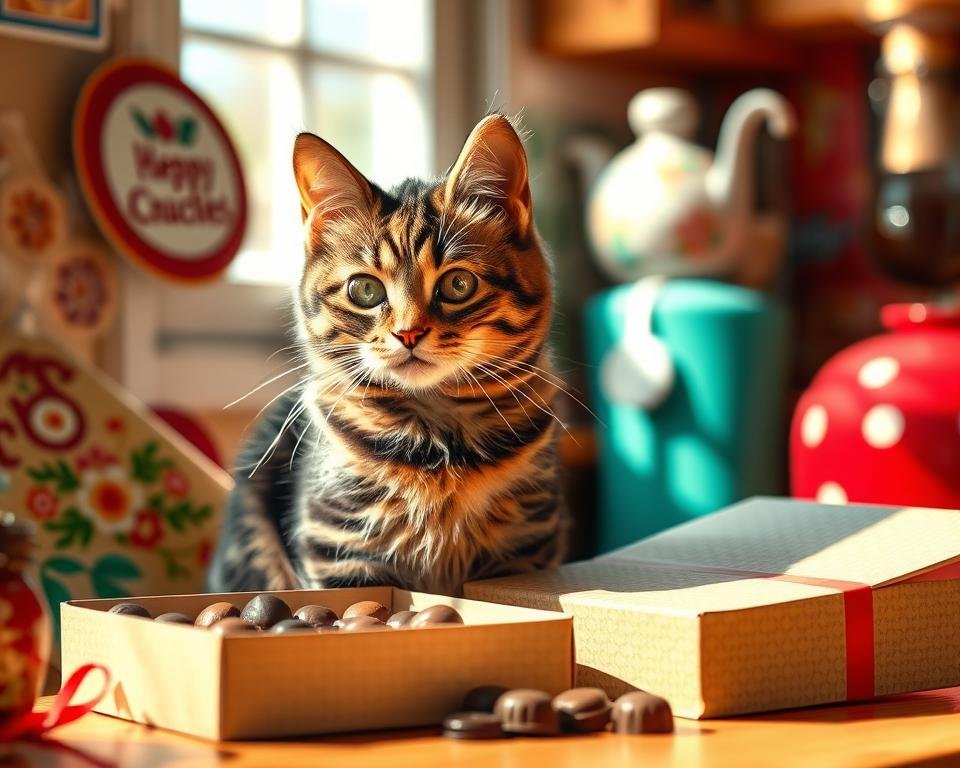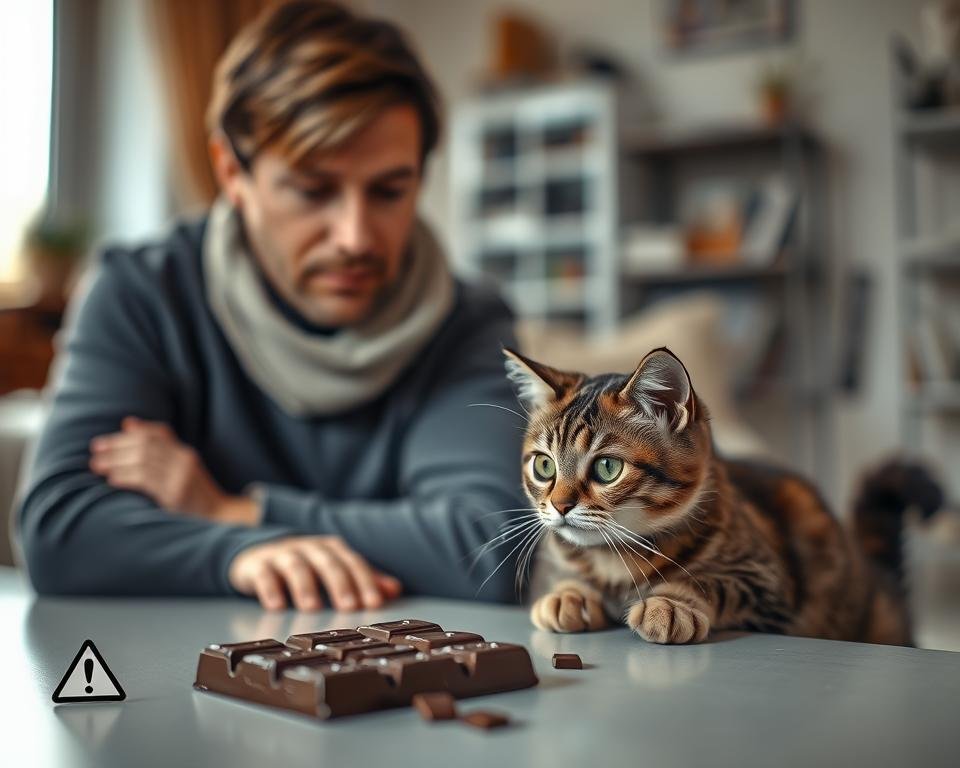Chocolate is a favorite treat for many, but it’s dangerous for cats. As cat owners, we must know the risks of chocolate for our pets. This guide will cover the dangers of chocolate for cats, including symptoms and how to keep your cat safe.
Chocolate has two harmful substances: theobromine and caffeine. These can hurt a cat’s stomach, heart, and brain. Knowing how different chocolates are toxic can help protect your cat.
Understanding Chocolate Toxicity in Cats
Chocolate is a favorite treat for people, but it’s dangerous for cats. Theobromine and caffeine in chocolate can harm cats badly. Unlike humans, cats can’t break down these substances well.
The Role of Theobromine and Caffeine
Theobromine and caffeine are the main culprits in chocolate toxicity for cats. They make cats’ nervous and heart systems work too hard. Cats and dogs can’t handle these substances as well as humans do.
Different Types of Chocolate and Their Toxicity Levels
Chocolate toxicity levels vary by type. Dark chocolate and baker’s chocolate are the most dangerous for cats because they have more theobromine. Milk chocolate and white chocolate are less risky but can also harm cats. Even a small amount of chocolate can be deadly for a cat.
How Chocolate Affects Cat’s Body Systems
Chocolate can harm a cat’s body in many ways. Symptoms include vomiting, diarrhea, and drinking a lot of water. Cats may also have an irregular heartbeat, be restless, breathe fast, or even have seizures. These symptoms can be very serious and even life-threatening.
If a cat eats chocolate, it needs to see a vet right away. Early treatment can help a cat recover faster. Never try to treat chocolate poisoning at home because it’s too risky. Knowing the dangers of chocolate helps keep cats safe.
Can Cats Have Chocolate: The Definitive Answer
No, cats cannot have chocolate. It’s toxic to them and can cause serious health issues. Chocolate has caffeine and theobromine, which are harmful to cats.
Even a small amount of chocolate can harm cats. For example, a small cat might get sick from 0.2 ounces of baker’s chocolate. Medium cats need to avoid 0.4 ounces, and big cats should stay away from 0.6 ounces. Dark and semi-sweet chocolates are the most dangerous.
Chocolate can make cats vomit, have diarrhea, and lose their appetite. They might also drink more water, breathe faster, and shake. In severe cases, cats can even go into a coma. Symptoms usually start within 12 hours and can get worse fast, so getting vet help right away is key.
In short, there’s no safe amount of chocolate for cats. Owners should keep chocolate away and never give it to their cats. There are safer treats that can satisfy their cravings without the danger of chocolate.
“Chocolate is not a necessary or safe snack for cats, and sharing chocolate with cats can have fatal consequences.”

The dangers of chocolate for cats are well-known. Responsible pet owners must keep their cats safe and healthy. By knowing the risks and taking steps to prevent them, cat owners can protect their pets from chocolate’s dangers.
Common Sources of Chocolate Exposure for Cats
Chocolate is a treat many enjoy, but it’s dangerous for cats. It’s important for pet owners to know where cats might find chocolate. This includes household items and hidden ingredients. Let’s look at how cats might get exposed to chocolate.
Household Chocolate Products
Cats can find chocolate in candies, baked goods, and drinks at home. These items are tempting for curious cats. They might not know the dangers of chocolate.
Holiday Hazards and Seasonal Risks
Holidays like Halloween and Christmas bring more chocolate into homes. This increases the chance of cats eating chocolate. It’s a risk to their health.
Hidden Sources of Chocolate
Chocolate can hide in unexpected places. Cats might find it in flavored medications or supplements. It’s also in some human foods. Owners need to check all items carefully.
Knowing where cats might find chocolate helps keep them safe. Owners should be careful with chocolate products. This way, cats can stay out of danger.

| Chocolate Type | Toxicity Level for Cats | Lethal Dose |
|---|---|---|
| Dark Chocolate | High | 0.5 oz per pound of body weight |
| Milk Chocolate | Moderate | 1 oz per pound of body weight |
| White Chocolate | Low | 4 oz per pound of body weight |
The table shows different chocolates are more or less toxic to cats. Owners must keep cats away from all chocolate. Even a little can harm them.
Signs and Symptoms of Chocolate Poisoning
As cat owners, knowing the dangers of chocolate is key. Chocolate has caffeine and theobromine, which can harm cats. Symptoms of chocolate poisoning in cats show up in six to 12 hours and can last up to four days.
The common signs include vomiting, diarrhea, and a drop in appetite. Cats may also drink more water, breathe faster, and act restless. Seizures, muscle tremors, and even coma or death can happen.
The danger depends on the chocolate type and amount. Darker chocolates are more dangerous because of their high theobromine and caffeine. Even white chocolate can be risky for cats because of their small size and sensitivity.
If you think your cat ate chocolate, get vet help right away. Quick action can save your cat’s life. Knowing the signs helps us keep our cats safe and healthy.
“Chocolate poisoning in cats is a serious threat that requires immediate action. Knowing the signs and symptoms can help pet owners respond quickly and effectively to protect their beloved feline companions.”
Immediate Actions When Your Cat Eats Chocolate
If your cat eats chocolate, act fast. Chocolate has theobromine and caffeine, which are toxic to cats. The danger level depends on the chocolate type and amount. But it’s always safer to be cautious.
Steps to Take in the First Hour
- Call your vet or the Pet Poison Helpline right away. They’ll tell you what to do next.
- Keep your cat inside and watch them for signs of trouble. Look for vomiting, diarrhea, more thirst, or restlessness.
- Take any leftover chocolate packaging or wrappers to the vet. This helps them figure out the right treatment.
What Not to Do at Home
Don’t try to make your cat vomit at home. Only a vet should do this. Trying to treat it yourself can harm your cat.
When to Contact Emergency Services
If your cat has bad symptoms like seizures, fast breathing, or an odd heartbeat, go to the emergency vet. Quick action is key for your cat’s safety.
Chocolate poisoning is a big risk for cats. But, with fast action and vet advice, you can protect your cat. Always keep chocolate and dangerous foods away from your cat.
Veterinary Treatment for Chocolate Poisoning
If a cat eats chocolate, it’s very important to get vet help fast. The vet will use many steps to treat chocolate poisoning in cats. This is because the symptoms can be very serious.
When the cat gets to the vet, they will check it carefully. The vet might also do tests like a urine sample and an ECG. These help figure out how bad the poisoning is and how it’s affecting the cat’s body.
- Induced vomiting: The vet might make the cat vomit. This helps get rid of any chocolate left in the stomach.
- Activated charcoal: The vet could give the cat activated charcoal. It helps grab onto the bad stuff and helps it leave the body.
- Fluid support: The cat might get fluids through an IV. This keeps them hydrated and helps their body get rid of the poison.
- Medication: The vet might give the cat medicine. This could be for things like a racing heart, seizures, or upset stomach.
In really bad cases, the cat might need to stay in the hospital. How long they stay depends on how bad the poisoning is and how well they’re doing with treatment.
Getting help right away is very important. Cats and chocolate poisoning can be very dangerous. By getting vet help fast, you can help your cat get better.
It’s also very important to prevent chocolate poisoning. Keep all chocolate away from cats. This way, you won’t have to worry about emergency vet visits.
Prevention Strategies and Safety Measures
Keeping your cat safe from chocolate is very important. You can do this by using smart storage and safety steps. A few simple actions can greatly lower the risk of your cat eating chocolate.
Safe Storage Solutions
First, make sure all chocolate is stored safely where your cat can’t get it. Use closed cabinets or refrigerators with pet-proof locks. This is very important during holidays when there’s more chocolate around.
Teach your family and guests about the dangers of chocolate for cats. Ask them to keep chocolate away from your pet.
Pet-Proofing Your Home
Make your home safe for your cat by pet-proofing it. Look for any spots where chocolate might be hidden. Use childproof latches on cabinets and drawers.
Use baby gates to block off areas your cat shouldn’t go into. Always clean up any chocolate that’s dropped to keep your cat safe.
By following these steps, you can keep your cat safe from chocolate. Always be careful and take action to protect your pet.
| Chocolate Type | Theobromine Content (mg/g) | Toxicity Level for Cats |
|---|---|---|
| Cocoa Powder | 20 | Highly Toxic |
| Dark Chocolate | 15 | Highly Toxic |
| Milk Chocolate | 2 | Moderately Toxic |
| White Chocolate | 0.1 | Minimally Toxic |
Some chocolates are more dangerous for cats than others. Always be careful and store chocolate properly to keep your cat safe.
Safe Alternatives to Chocolate for Cats
Chocolate is yummy for us, but it’s bad for cats. It can make them sick with vomiting, diarrhea, and seizures. Luckily, there are safe treats that cats can enjoy without the danger of chocolate.
Carob is a great choice. It looks and feels like chocolate but is safe for cats. It’s a fun, safe treat for your pet.
Cats need meat for nutrients, but some treats can help too. Look for treats that help with dental health or add vitamins. Treats should be a small part of their diet, with good cat food being the main thing.
Non-food rewards like play and attention are great for cats. Playing with them or giving them a favorite toy is just as good as treats. It’s safe and fun for them.
| Toxic Food for Cats | Safe Alternatives |
|---|---|
| Chocolate | Carob, meat-based cat treats |
| Grapes and raisins | Feline-safe fruits and veggies |
| Onions and garlic | Protein-rich cat food |
| Alcohol | Clean water |
| Raw meat and raw eggs | Cooked, commercial cat food |
Keeping your cat safe is key. Give them safe treats and positive rewards. This way, your cat can have fun and stay healthy without the dangers of chocolate.
“Cats should be provided with fresh, clean water and offered meat-based treats in moderation to prevent obesity and related health issues.”
Conclusion
Chocolate is never safe for cats. As pet owners, we must keep chocolate away from them. This is to protect their health and well-being.
We need to know the dangers of chocolate for cats. We should also know how to act if they accidentally eat it. This is key to keeping our cats safe and healthy.
Teaching ourselves and others about cat safety is important. We can choose safe treats for our cats instead of chocolate. This way, we can give them treats without harming them.
The bottom line is clear – cats should not have chocolate. By focusing on our cats’ safety, we can make sure they live long, happy lives. And they will be free from the dangers of chocolate.
FAQ
Can cats have chocolate?
No, cats can’t have chocolate. It’s toxic to them because of theobromine and caffeine. These can harm their stomach, heart, and brain.
What types of chocolate are dangerous for cats?
Cocoa powder and baker’s chocolate are the most dangerous. They have a lot of theobromine and caffeine. White chocolate is also harmful, but less so.
How can chocolate affect a cat’s body?
Chocolate can make cats vomit and have diarrhea. It can also make them hyperactive and thirsty. They might have a fast heart rate and trouble walking. Seizures can happen too, and it can even be deadly
Where can cats find chocolate in a household?
Cats can find chocolate in many places. It’s in candies, baked goods, and drinks. Even some supplements have chocolate. Holidays are a big risk because there’s more chocolate around.
What should I do if my cat eats chocolate?
If your cat eats chocolate, call your vet or the Pet Poison Helpline right away. Don’t try to make them vomit at home. Keep them inside and watch them closely. Bring any packaging to the vet.
How is chocolate poisoning in cats treated?
Vets might make them vomit, give activated charcoal, and fluids. They might also give medicine to help with symptoms. The vet will do tests like a physical exam and ECG.
How can I prevent chocolate poisoning in my cat?
Keep all chocolate out of reach. Use locks if you need to. Be careful during holidays when there’s more chocolate around. Don’t leave chocolate gifts or Easter baskets where cats can get them.
What are safe alternatives to chocolate for cats?
Give cats special treats made just for them. Look for ones that are healthy. Treats should be a small part of their diet. You can also use non-food rewards like playtime and affection.



